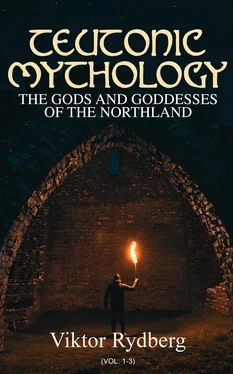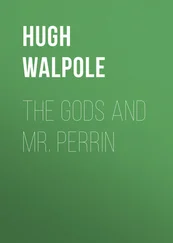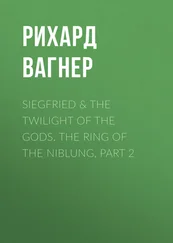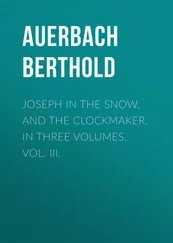Viktor Rydberg - Teutonic Mythology - The Gods and Goddesses of the Northland (Vol. 1-3)
Здесь есть возможность читать онлайн «Viktor Rydberg - Teutonic Mythology - The Gods and Goddesses of the Northland (Vol. 1-3)» — ознакомительный отрывок электронной книги совершенно бесплатно, а после прочтения отрывка купить полную версию. В некоторых случаях можно слушать аудио, скачать через торрент в формате fb2 и присутствует краткое содержание. Жанр: unrecognised, на английском языке. Описание произведения, (предисловие) а так же отзывы посетителей доступны на портале библиотеки ЛибКат.
- Название:Teutonic Mythology: The Gods and Goddesses of the Northland (Vol. 1-3)
- Автор:
- Жанр:
- Год:неизвестен
- ISBN:нет данных
- Рейтинг книги:4 / 5. Голосов: 1
-
Избранное:Добавить в избранное
- Отзывы:
-
Ваша оценка:
- 80
- 1
- 2
- 3
- 4
- 5
Teutonic Mythology: The Gods and Goddesses of the Northland (Vol. 1-3): краткое содержание, описание и аннотация
Предлагаем к чтению аннотацию, описание, краткое содержание или предисловие (зависит от того, что написал сам автор книги «Teutonic Mythology: The Gods and Goddesses of the Northland (Vol. 1-3)»). Если вы не нашли необходимую информацию о книге — напишите в комментариях, мы постараемся отыскать её.
One of Rydberg's mythological theories developed in this book is that of a vast World Mill which rotates the heavens, which he believed was an integral part of Old Norse mythic cosmology.
Teutonic Mythology: The Gods and Goddesses of the Northland (Vol. 1-3) — читать онлайн ознакомительный отрывок
Ниже представлен текст книги, разбитый по страницам. Система сохранения места последней прочитанной страницы, позволяет с удобством читать онлайн бесплатно книгу «Teutonic Mythology: The Gods and Goddesses of the Northland (Vol. 1-3)», без необходимости каждый раз заново искать на чём Вы остановились. Поставьте закладку, и сможете в любой момент перейти на страницу, на которой закончили чтение.
Интервал:
Закладка:
The explanation of the fact is, as shall be shown below, that Frey, on account of a passion of which he is the victim (probably through sorcery), was driven to marry the giant maid Gerd, whose kin in that way became friends of the Vans. Frey is obliged to demand satisfaction for a murder perpetrated on a kinswoman of his wife. The kinship of blood demands its sacred right, and according to Teutonic ideas of law, the Vans must act as they do regardless of the moral character of Gulveig.
35.
GULVEIG-HEIDR. HER IDENTITY WITH AURBODA, ANGRBODA, HYRROKIN. THE MYTH CONCERNING THE SWORD GUARDIAN AND FJALAR.
Table of Contents
The duty of the Vana-deities becomes even more plain, if it can be shown that Gulveig-Heid is Gerd's mother; for Frey, supported by the Vana-gods, then demands satisfaction for the murder of his own mother-in-law. Gerd's mother is, in Hyndluljod, 30, called Aurboda, and is the wife of the giant Gymer:
Freyr atti Gerdi,
Hon vor Gymis dottir,
iotna ættar
ok Aurbodu.
It can, in fact, be demonstrated that Aurboda is identical with Gulveig-Heid. The evidence is given below in two divisions. (a) Evidence that Gulveig-Heid is identical with Angerboda, "the ancient one in the Ironwood;" (b) evidence that Gulveig-Heid-Angerboda is identical with Aurboda, Gerd's mother.
(a) Gulveid-Heid identical with Angerboda.
Hyndluljod, 40, 41, says:
Ol ulf Loki
vid Angrbodu,
(enn Sleipni gat
vid Svadilfara);
eitt thotti skars
allra feiknazst
that var brodur fra
Byleistz komit.
Loki af hiarta
lindi brendu,
fann hann haalfsuidinn
hugstein konu;
vard Loptr kvidugr
af konu illri;
thadan er aa folldu
flagd hvert komit.
From the account we see that an evil female being ( ill kona ) had been burnt, but that the flames were not able to destroy the seed of life in her nature. Her heart had not been burnt through or changed to ashes. It was only half-burnt ( hálfsvidinn hugsteinn ), and in this condition it had together with the other remains of the cremated woman been thrown away, for Loke finds and swallows the heart.
Our ancestors looked upon the heart as the seat of the life principle, of the soul of living beings. A number of linguistic phrases are founded on the idea that goodness and evil, kindness and severity, courage and cowardice, joy and sorrow, are connected with the character of the heart; sometimes we find hjarta used entirely in the sense of soul, as in the expression hold ok hjarta , soul and body. So long as the heart in a dead body had not gone into decay, it was believed that the principle of life dwelling therein still was able, under peculiar circumstances, to operate on the limbs and exercise an influence on its environment, particularly if the dead person in life had been endowed with a will at once evil and powerful. In such cases it was regarded as important to pierce the heart of the dead with a pointed spear (cp. Saxo, Hist. , 43, and No. 95).
The half-burnt heart, accordingly, contains the evil woman's soul, and its influence upon Loke, after he has swallowed it, is most remarkable. Once before when he bore Sleipner with the giant horse Svadilfare, Loke had revealed his androgynous nature. So he does now. The swallowed heart redeveloped the feminine in him ( Loki lindi af brendu hjarta ). It fertilised him with the evil purposes which the heart contained. Loke became the possessor of the evil woman ( kvidugr af konu illri ), and became the father of the children from which the trolls ( flagd ) are come which are found in the world. First among the children is mentioned the wolf, which is called Fenrir , and which in Ragnarok shall cause the death of the Asa-father. To this event point Njord's words about Loke, in Lokasenna, str. 33: ass ragr er hefir born of borit . The woman possessing the half-burnt heart, who is the mother or rather the father of the wolf, is called Angerboda ( ól ulf Loki vid Angrbodu ). N. M. Peterson and other mythologists have rightly seen that she is the same as "the old one," who in historical times and until Ragnarok dwells in the Ironwood, and "there fosters Fenrer's kinsmen" (Völuspa, 39), her own offspring, which at the close of this period are to issue from the Ironwood, and break into Midgard and dye its citadels with blood (Völuspa, 30).
The fact that Angerboda now dwells in the Ironwood, although there on a former occasion did not remain more of her than a half-burnt heart, proves that the attempt to destroy her with fire was unsuccessful, and that she arose again in bodily form after this cremation, and became the mother and nourisher of were-wolves. Thus the myth about Angerboda is identical with the myth about Gulveig-Heid in the two characteristic points:
Unsuccessful burning of an evil woman.
Her regeneration after the cremation.
These points apply equally to Gulveig-Heid and to Angerboda, "the old one in the Ironwood."
The myth about Gulveig-Heid-Angerboda, as it was remembered in the first period after the introduction of Christianity, we find in part recapitulated in Helgakvida Hundingsbane, i. 37–40, where Sinfjotle compares his opponent Gudmund with the evil female principle in the heathen mythology, the vala in question, and where Gudmund in return compares Sinfjotle with its evil masculine principle, Loke.
Sinfjotle says:
Thu vart vaulva
i Varinseyio,
scollvis kona
bartu scrauc saman;
Thu vart, en scetha,
scass valkyria,
autul, amátlig
at Alfaudar;
mundo einherjar
allir beriaz,
svevis kona,
um sakar thinar.
Nio attu vith
a neri Sagu
ulfa alna
ec var einn fathir theirra.
Gudmund's answer begins:
Fadir varattu
fenrisulfa. …
The evil woman with whom one of the two heroes compares the other is said to be a vala, who has practised her art partly on Varin's Isle partly in Asgard at Alfather's, and there she was the cause of a war in which all the warriors of Asgard took part. This refers to the war between the Asas and Vans. It is the second feud among the powers of Asgard.
The vala must therefore be Gulveig-Heid of the myth, on whose account the war between the Asas and Vans broke out, according to Völuspa. Now it is said of her in the lines above quoted, that she gave birth to wolves, and that these wolves were "fenrisulfar." Of Angerboda we already know that she is the mother of the real Fenris-wolf, and that she, in the Ironwood, produces other wolves which are called by Fenrer's name ( Fenris kindir —Völuspa). Thus the identity of Gulveig-Heid and Angerboda is still further established by the fact that both the one and the other is called the mother of the Fenris family.
The passage quoted is not the only one which has preserved the memory of Gulveig-Heid as mother of the were-wolves. Volsungasaga (c. ii. 8) relates that a giantess, Hrímnir's daughter, first dwelt in Asgard as the maid-servant of Frigg, then on earth, and that she, during her sojourn on earth, became the wife of a king, and with him the mother and grandmother of were-wolves, who infested the woods and murdered men. The fantastic and horrible saga about these were-wolves has, in Christian times and by Christian authors been connected with the poems about Helge Hundingsbane and Sigurd Fafnersbane. The circumstance that the giantess in question first dwelt in Asgard and thereupon in Midgard, indicates that she is identical with Gulveig-Heid, and this identity is confirmed by the statement that she is a daughter of the giant Hrímnir .
The myth, as it has come down to our days, knows only one daughter of this giant, and she is the same as Gulveig-Heid. Hyndluljod states that Heidr is Hrímnir's daughter, and mentions no sister of hers, but, on the other hand, a brother Hrossthiofr ( Heidr ok Hrorsthiofr Hrimnis kindar —Hyndl., 30). In allusion to the cremation of Gulveig-Heid fire is called in Thorsdrapa Hrimnis drósar lyptisylgr , "the lifting drink of Hrimner's daughter," the drink which Heid lifted up on spears had to drink. Nowhere is any other daughter of Hrimner mentioned. And while it is stated in the above-cited strophe that the giantess who caused the war in Asgard and became the mother of fenris-wolves was a vala on Varin's Isle ( vaulva i Varinseyio ), a comparison of Helgakv. Hund., i. 26, with Volsungasaga, c. 2, shows that Varin's Isle and Varin's Fjord were located in that very country, where Hrimner's daughter was supposed to have been for some time the wife of a king and to have given birth to were-wolves.
Читать дальшеИнтервал:
Закладка:
Похожие книги на «Teutonic Mythology: The Gods and Goddesses of the Northland (Vol. 1-3)»
Представляем Вашему вниманию похожие книги на «Teutonic Mythology: The Gods and Goddesses of the Northland (Vol. 1-3)» списком для выбора. Мы отобрали схожую по названию и смыслу литературу в надежде предоставить читателям больше вариантов отыскать новые, интересные, ещё непрочитанные произведения.
Обсуждение, отзывы о книге «Teutonic Mythology: The Gods and Goddesses of the Northland (Vol. 1-3)» и просто собственные мнения читателей. Оставьте ваши комментарии, напишите, что Вы думаете о произведении, его смысле или главных героях. Укажите что конкретно понравилось, а что нет, и почему Вы так считаете.











